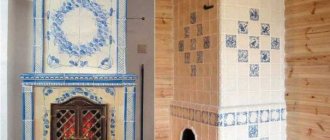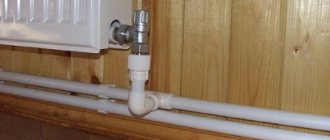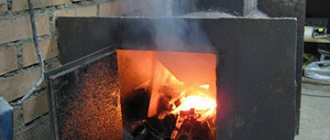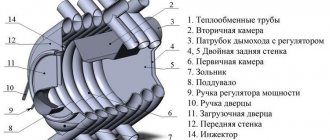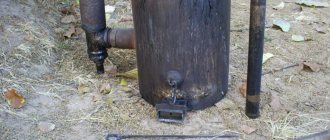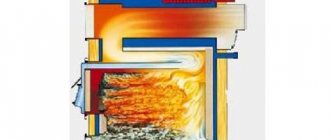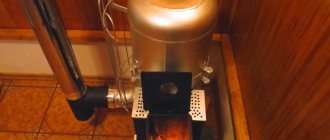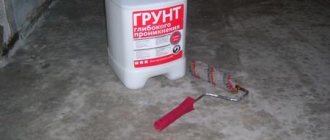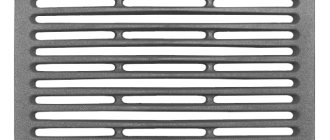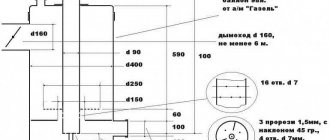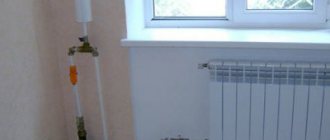Benefit for the buyer
1. Save time
Today it is important to receive a complete chain of services in one place. We have already spent time searching and checking teams for you.
2. Think about safety
Stoves, fireplaces and boilers are sources of extreme temperatures up to 750 °C. Special knowledge is required to install such equipment safely and avoid fire.
3. Making life more convenient
Installation by specialists is fast, safe and free from hassle. You won’t have to calculate the estimate yourself, go for missing materials, and there won’t be any left over.
4. We comply with warranty conditions
If you encounter any problems with the operation of your stove, boiler or fireplace, please contact the manufacturer. Most manufacturers guarantee the correct functioning of the product only when installed by professionals.
Advantages and disadvantages
The devices have a whole list of advantages that are very valuable for products of this kind. Among them it is worth highlighting the main aspects:
- quite convenient installation that does not require specific skills and the construction of additional foundations;
- rapid removal of ash, which can be done even during combustion;
- The design of the heating stove by Professor Butakov “Student” provides for an organic combination with any interior.
- large heating area;
- presence of air cooling;
- sufficient dimensions of the heating surface;
- functional firebox, equipped with control of air supply, as well as combustion intensity;
- replaceable grates.
Advantages of our partners
1. Free of charge – engineer’s visit for measurements
When ordering, an inspection of the facility where the work will be carried out takes place. The cost of travel is 2000 rubles up to 50 km from the Moscow Ring Road, then it is negotiated individually in each case. But this amount is deducted from the total cost in the final calculation. If you want to speed up the process, save time and pay for installation services in full after signing the acceptance certificate, you can inspect the property online.
2. Wide range of works
Professional teams offer a different range of services: from chimney installation to decorative finishing of the fireplace. You don’t have to look for loaders, installers, or plasterers; our partners will complete the installation on a turnkey basis.
3. Flexible price
It is not necessary to order all possible services when, for example, you can properly organize thermal insulation yourself. Save money on this.
4. Reliability
Before installation, an agreement is concluded, without which no self-respecting team works. He confirms what and how will be done. After the services are completed, a transfer and acceptance certificate is signed. Please check your work carefully upon receipt!
5. 1 year warranty
The installation work carried out is guaranteed for 1 year. If during this time you discover defects caused by the actions of the installers, corrections are carried out at the expense of this team.
Order an engineer visit or
Characteristics
Considering that the Butakov “Student” furnace has various modifications, their sizes and technical characteristics differ significantly. What these devices have in common is the presence of built-in convective channels used to increase heat transfer. Depending on the type, stoves can work both to heat air and provide water heating.
Wood burning stove
This device is characterized by maximum thermal efficiency and high efficiency, in comparison with coal analogues. It has the following features:
- Tightness of the combustion chamber - the door closes securely, eliminating the formation of cracks.
- Improved control of air supply - the unique design of the gate valve allows you to set gas generation or simply combustion modes.
- High-quality materials - thick-walled structural steel was used to make the body, cast iron was used for the grates and doors.
In addition, the device is characterized by relatively small dimensions, which are:
- 530*780*370 mm;
- chimney pipe diameter 120 mm;
- weight of the entire oven is 77 kg;
- firebox volume 74 l;
- power reaches 9 kW;
- Efficiency is 85%.
The Student stove has an amazing ability to prevent soot from contaminating work surfaces. Even long-term use will not affect the cleanliness of the glass. The burning duration allows you to make bookmarks no more than once every 6-7 hours. The device is equipped with a replaceable grate, which allows air flows to be evenly distributed in the fuel chamber. This eliminates the formation of soot. The design of the ash box allows it to be cleaned without interrupting the combustion process.
Coal furnace
When designing these heating furnaces, the intensity of the thermal load was taken into account. The device has the following characteristics:
- weight – 77 kg;
- firebox volume – 70 l;
- dimensions – 530*370*780 mm;
- Efficiency – 85%;
- Power – 9 kW.
Burning coal requires more oxygen than wood, but produces significantly more heat. Thanks to the 5 mm wall thickness, metal deformation, which can cause rapid breakdown of the furnace, is eliminated. The tightness and thoughtfulness of the design can significantly reduce coal consumption. A similar stove by Professor Butakov “Student”, operating on coal, is an ideal option for systematic heating.
Hydraulic
Thanks to the unique design of the heat exchanger, the long-burning Student water-heating stove has a fairly high heat output. The usual coils in it were replaced with convective channels, partially recessed into the firebox. Thanks to these features, the liquid is intensely heated and enters the heating system. This large-sized device has the following characteristics:
- weight - 90 kg;
- power - 16 kW;
- firebox – 70 l;
- dimensions – 720*370*770 mm;
- Efficiency – 85%.
In addition, the design provides for the installation of heating elements, which allows you to maintain the temperature of the coolant for a long time.
Features of the “Student” furnace design Hydraulic
DIY installation
First you need to know the requirements of fire safety rules SP 7.13130.2013. This is the main document in the Russian Federation used when installing boilers, stoves and fireplaces. Next, you need to understand the amount of materials needed, including fasteners, chimney elements, and even tiles with adhesive. You will also need knowledge of the physical and chemical properties of these materials in order to work and apply them correctly. Don't forget to take at least one assistant. It will be difficult for one person to install a stove and chimney; heating equipment weighs up to 400 kg, and the pipes themselves are only light at first glance. We will be glad if you master the intricacies of installing stoves, fireplaces, and boilers. Perhaps in the future you will become our partner.
Installation of the stove “Professor Butakov” model “Student”
The stove, as you know, is the heart of the house.
I started looking closely at stoves back at the construction seminar in the Ark (January 2007). At that time I was more interested in iron ones, because... I was going to build myself a change house, and naturally I didn’t even think about a brick one. So, I’ve already seen how an ordinary potbelly stove works using Zhenya’s example. It heats up well and... cools down very quickly. And so, in the Ark I see and touch with my hands the stoves of slow (long) burning (or smoldering). First of all, these are Bulleryans (now they are sold under the Brenneran brand).
A miracle of Canadian industry with protruding pipes, these stoves looked truly wonderful.' Many people had such stoves, including those in the common house. Stoves of this type operate in two modes - in the “potbelly stove” mode and in the gas generation mode. In the first mode, all dampers (the damper on the pipe and on the firebox lid) are open. The stove heats up quickly and strongly, and the first layer of coals forms. After this, more firewood is added, and the front flap closes (or rather, a small crack remains). Thus, the flow of cold air, and therefore the draft, is practically reduced to zero. And the stove goes into the second mode - the wood smoldering mode. In this mode, fuel combustion is extremely slow with minimal oxygen supply. This mode allows you to maintain a comfortable indoor temperature for a long time. A design feature of such furnaces is the presence of convective heat exchange pipes. These pipes start at the bottom of the stove, pass through the firebox, and exit at the top. Cold air (from the floor) from outside the stove enters this pipe from below, passes through the firebox (where it heats up) and goes outside (where it rises to the ceiling). Well, warm air from the ceiling gradually falls down.
In general, I really liked these stoves; the guys (and they live there all year round) in the Ark told a lot about their operation. The main thing is that the stove can actually work all night, gradually releasing heat. Firewood or boots are dried on the upper chimneys. The main trouble with all slow-burning stoves is that condensation forms inside the pipe during operation. This is a black, stinking slurry that is difficult to wash off. To reduce its formation to a minimum, and to ensure that it does not flow out of all the cracks in the pipe joints, it is necessary to install the pipes “through water”, i.e. insert the top one into the bottom one. And of course, use sandwich pipes - i.e. insulated pipes.
Why am I singing the defamations of this stove? Simply because these stoves were the first in their class, and the first that I became acquainted with. By the way, these stoves began to be produced in Canada in the 60s.
But in one house in the Ark I saw another stove, and immediately fell in love with it. It was "Professor Butakov". Neat, without protruding pipes, with gilded pipe necks - it was simply beautiful. It turned out that it was made in Novosibirsk and works on the same principle as Bulleryan... only better. On the Termofor website you can find a comparison of their stove with the Canadian one. Of course, this is primarily an advertisement, but... there really are more pipes, they pass their entire length through the firebox, the stove has the shape of a flame, pipes of a larger cross-section (when comparing models with identical characteristics), there is an ash drawer and a grate (Bulleryan does not have them). The stove takes up less space. Butakov’s total heating area is 90% (!) larger. Well, and a small trifle in the form of a flat surface on which you can heat, for example, water. In addition, this is a stove of modern design.
Furnaces "Professor Butakov"
After that, in general, I was no longer tormented by the choice of which stove I would install in my future change house. I’ll say right away that all these stoves, of course, are in no way comparable to a brick one, but they have the right to live in our small houses.
The “Professor Butakov” stove line now has 5 standard sizes, differing in the volume of the room they are designed for: Gymnasium student-100, Student-150, Engineer-250, Associate Professor-500, Professor-1000. Currently, the “Gymnasium Student” model is no longer produced by the plant, but it can still be bought on the markets. This stove is a little different from other models, so a few words about it (in the picture above it is on the far left). In terms of size and weight, it is fully consistent with the “Student”, but it only has 8 convective pipes. The combustion door is round and without an additional casing (since there are no pipes on the front wall). There is no grate or ash drawer. The incoming air regulator is the same as on the Bulleryan - a round gate on the combustion door. The bottom of the firebox is flat - this, of course, makes it easier to remove ash. My opinion is that the presence of a grate and an ash bin is good, and their absence is bad - but I cannot prove it.
I know two more manufacturers of slow burning stoves - Teplodar and Chenel. “Chenel” is very similar in appearance to Bulleryan, but there is a hob on the stove. There are no convection pipes; the air passes under the outer casing over the entire surface. I didn’t look inside, but it looks like there is no grate or ash pan. The disadvantage of these stoves seemed to me to be the small power and volume of the heated room. Plus, I haven’t found these stoves cheaper.
Heating and cooking stoves "Chenel"
I won’t say almost anything about Teplodar, but apparently, instead of convective pipes, it uses an external casing, just like in Chenel. This doesn't seem very powerful to me. There are only two modifications (standard sizes), and the first of them is only 50-100 cubic meters. Plus, the manufacturer’s website was not impressed by the operating time on one stack of firewood - 3-3.5 hours... Pros - low price (compared to Butakov), there is a hob, there is an ash pan (and therefore a grate), the water tank is easy to install ( i.e. there are tanks that are immediately “tailored” for this stove). And I couldn’t find any information on how to use them. Although Volodya bought such a stove from us from field I6.
Teplodar stoves
So,
the advantages
of such stoves: • quick heating of the room; • give off heat for a long time; • lightweight, can be installed without a foundation, although installation requires careful attention (see below).
Minuses
such stoves: • there is always smoke coming out of the chimney when you heat the stove; • quite high cost (especially of “older” models) of the stove and pipes; • such ovens promote active mixing of air that passes through hot convection pipes. The dust present in the air burns in these pipes => combustion products appear that we breathe. Those. these stoves are far from being called “ecological”; • caustic condensate forms on the inner walls of the pipe. The pipe must be cleaned regularly.
An alternative to such stoves that covers all their disadvantages is a brick stove. But, as I already said, in my opinion, it makes no sense to install it in a small house that doesn’t even have a foundation. Because such ovens require at least their own foundation, and take up more space than the above. Well, they cost more.
Not everything is probably enough for entry. I built my house last year, but I couldn’t buy a stove - there was no money, then there was no road... And only recently all these things appeared at the same time. I didn’t think for long, and quickly went to the market to buy a stove.
PURCHASE
I chose the “Student” model - it is small and designed for 150 cubic meters (and my house (2 floors) is 80 cubic meters), i.e. - Enough for the eyes. Here are its characteristics: Conventional models have a double firebox door made of iron. The inner one is round (i.e. the entrance to the firebox is round), the outer one is rectangular, it serves as a protective casing. Starting with the “Student”, these stoves can be equipped with a cast-iron door with fireproof viewing glass. In this case, the entrance to the firebox is rectangular. Knowing full well that this glass would become smoked in no time, I nevertheless decided to pay an additional 1,500 rubles for such a door. Still a “cast iron”!! And it looks more beautiful.
I bought it at the Abramtsevo market in Moscow here. I liked the salesman there (a young guy) who picked out all the other components for me. Later I found another place - this is the market on Yaroslavka, when you drive from Moscow, you pass the traffic police post (the bridge crossing with the concrete street, Sofrino), and immediately to the right of the road. There are two points where these stoves are sold, and in one of them there is a salesman, Anatoly. This stove is 500 rubles cheaper. Good water tanks. But he believes that the chimney should be assembled according to the “smoke”... And besides, he was a little under the gun.
So, below is the estimate for the stove:
Price:
• Stove “Professor Butakov - student” with glass: 11800 rub. • Tank 55 l on a pipe: 3500 rub. • Sandwich pipe 1 m stainless/galvanized. d115: 4pcs x 1000 = 4000r • Plug: 350r • Cutting (40×40 cm) + basalt insulation: 1450r • Corner “Skirt” + “Gusset”: 1120r • Head: 650r • Thermo-sealant: 150r • Galvanized iron sheets ( 1×2 m): 3pcs x 445 RUR = 1335RUR • Asbestos cardboard (0.8×1 m): 3pcs x 105 = 315RUR • Curb stone: 2pcs x 80 = 160RUR • Ceramic tubes in a set of 4 pcs: 3pcs x 105RUR = 315r • 1/2 inch faucet + coupling: 226r
TOTAL: 25371 rub.
Marked in blue is everything that I took in “Abramtsevo” in “Pechka-Kamenka”. In green - in other places, namely: Sheets of iron, faucet and asbestos cardboard - at the Khozyain and Gorodok markets in Khotkovo, and curb stones - in Zhuchki (on the road). He took everything away in one go in his car.
INSTALLATION
Of course, I was going to edit it myself - otherwise I wouldn’t have written this article. I found out about the installation and the peculiarities of these stoves in advance on the Internet (see links at the end) on forums, and our neighbors helped with advice.
So... mid-afternoon, November 2, 2008. My car was only able to drive as far as the entrance to our field. It’s good that Ivan drove by with his truck - otherwise I don’t even know how I would have stomped 70 kg through the mud...
Before installation, I drew a small plan for the upcoming work. The installation steps were as follows:
1) Preparing the place where the stove will stand: protecting the walls and floor with fireproof materials. 2) Determining the location of the pipe passage. Cut a square hole in the ceiling. Protection of the ceiling with fireproof materials (basalt cardboard, metal sheets, cutting box, basalt wool). 3) Installing the stove on the stand. Installation of damper and water tank using sealant. 4) Sequential installation of pipe segments (using sealant). Ceiling passage, exit to the ceiling of the 2nd floor. Determining the location of the passage through the roof. 5) Make a hole in the roof large enough for the pipe to pass through. 6) Deliver the remaining pipe segments. 7) On the outside of the roof, put a “skirt” on the pipe and place it under the ridge. Place a “kerchief” and a cap on the pipe. Make a hole in the roof slab using basalt wool.
2) Determining the location of the pipe passage. Cut a square hole in the ceiling. Protection of the ceiling with fireproof materials (basalt cardboard, metal sheets, cutting box, basalt wool). 3) Installing the stove on the stand. Installation of damper and water tank using sealant. 4) Sequential installation of pipe segments (using sealant). Ceiling passage, exit to the ceiling of the 2nd floor. Determining the location of the passage through the roof. 5) Make a hole in the roof large enough for the pipe to pass through. 6) Deliver the remaining pipe segments. 7) On the outside of the roof, put a “skirt” on the pipe and place it under the ridge. Place a “kerchief” and a cap on the pipe. Make a hole in the roof slab using basalt wool.
So, now in more detail, point by point.
The walls and floor are protected with asbestos cardboard and stainless steel sheets. Additional stainless steel sheets are hung on the walls at some distance from the wall (air gap). The base under the stove is two paving slabs
Since my stove would be very close to combustible wooden structures (walls), even without instructions it was clear that they needed to be protected with something fireproof. Now there is such a pleasant and environmentally friendly material “minrite”, but it is quite expensive (600 rubles/m2), so I decided to make do with sheets of galvanized iron + asbestos cardboard. I nailed sheets of asbestos cardboard onto the walls and floor, and then covered them with a galvanized sheet (with screws). In principle (this can already be seen now, after operation), this would be enough. But I decided to “aggravate” the protection and added another galvanized sheet to the walls, placing it at some distance from the wall so as to create an air gap. I attached this sheet to ceramic tubes. I simply placed two curb stones under the stove. The place for the stove is ready.
A hole is cut in the ceiling (in my case 40x40). The perimeter is lined with basalt fiber (cardboard?). I also hit with iron
The hardest part was cutting a square hole in the ceiling without electricity, but I managed to do the job. The dimensions of the hole were two to three centimeters larger than the dimensions of the cutting box. All means were used to protect the ceiling (this hole), because... they say that this is the most fire-hazardous place. I first laid it around the perimeter (along the walls of the ceiling) with basalt cardboard - with a bend on the ceiling of the 1st floor and on the floor of the 2nd (secured with a stapler). After that, I covered the perimeter with galvanized strips. The result was a neat metal box.
The box is simply inserted into the cut opening. There is an air gap between the cutting and the walls of the ceiling
I inserted a cutting box into this box from below, and since the hole was cut 2-3 centimeters larger, the cutting easily fit into the hole and there was still an air gap of 1.5 cm between its walls and the walls of my box. The passage through the ceiling was ready.
Somehow I installed the stove on the curb stone and achieved balance. I installed a standard damper (damper) in the smoke hole, and soulfully coated everything with thermal sealant (this is a special sealant for chimneys, it holds 1500 degrees). After that, I installed a water tank on the gate.
Actually, by design, there is no water tank. But it immediately seemed to me that free hot water (when the stove is on) would never hurt, so I decided to install a tank in my place.
There will always be hot water in this tank (when the stove is fired). Tank 50l. Faucet sold separately
The main difficulty here is to correctly connect the gate, tank and pipes so that all joints are made “on the water”, i.e. so that the upper pipe is inserted into the lower one. Then the condensate will flow down the pipe and burn in the firebox. To prevent smoke from the chimney from entering the room, you need to:
a) Seal the joints well;
b) Use sandwich pipes.
Sandwich pipes are naturally more expensive than regular pipes, but it is their presence (i.e. insulation of the pipe) that reduces the formation of condensate in the pipe. The only thing is that the first meter of pipe from the stove is made from an ordinary, single pipe, because... the sandwich will interfere with the damper, and it’s difficult to put it on the gate.
So about the tank. It turned out that choosing one that meets all the conditions for joining pipes is not an easy task. The fact is that this particular stove model has a recommended pipe diameter of 120 mm (12 cm), and water tanks are mounted on a pipe of 110, 115... Which is exactly what I did. I took a water tank with a pipe with a diameter of 115 mm. We also tried it on in the store - the lower end of the tank pipe fits perfectly onto the standard stove valve (the only “wrong” place). And the inner pipe of the sandwich is inserted into the upper end - also 115mm. Those. I reduced the diameter of the work by 5mm, but everything assembles perfectly - just as I need it. The only thing that had to be slightly altered by hand (and even then by the hands of the seller) was the relative position of the inner and outer pipes in the sandwich. The sandwich is an inner pipe (stainless steel), an outer one (galvanized) and between them is filled with non-flammable basalt insulation. So, usually both the inner and outer pipes have a narrowing on one side, but for me the seller turned them over, i.e. the inner one tapers on one side, and the outer one on the other. The pipe head just fits over the narrowing. So I tried to show it in this diagram.
So, then I put the tank on the valve (everything is coated with sealant). A sandwich pipe has already gone into the tank pipe above. To prevent insulation from spilling into my tank, it is closed at the bottom with a plug. The pipe has already passed through the ceiling (by the way, it is recommended to calculate the length of the pipes so that the joints are NOT in the ceilings). When cutting, I laid basalt wool around the pipe and closed it with a hatch on top.
All pipes are a “sandwich”, i.e. insulated, double. The entire pipe system, starting from the water tank, is assembled along “water” so that condensate flows into the pipe (and ultimately into the stove). The first pipe segment is plugged with a plug from below.
I won’t describe the agony of cutting a round hole in my metal tiles... I’ll say right away that there’s nothing to do here without the help of electricity. Fortunately, at that time a neighbor brought an inverter - I was sawing out the roof with a jigsaw. After this, we sawed off the interfering laths and quickly assembled the entire pipe. Then everything is simple. A “skirt” is put on the pipe, and the short one is attached to the roof. The skirt should fit under the ridge to prevent streams of rain from flowing into the hole. I solved this problem using a piece of galvanized steel. A ring called a “scarf” is put on the pipe, which closes the gap between the pipe and the “skirt”. Well, the crown of the pipe is the head. He's just getting dressed.
Since the “skirt” is not very wide, I had to foam its side edges - otherwise the side rain would penetrate into the hole under it.
That's all. Installation is ready.
EXPLOITATION
A few words about operation, I think when I have more experience, I will publish it separately. The first firing of the stove is a terrible smoke. All factory oils/paints burn out. Even the instructions say this - it is recommended to carry out the first kindling outside... In general, I opened all the doors and windows, and heated the stove in intensive mode for about an hour. Already after the second kindling there was almost no smell, although it was still noticeable.
What can I say. So far everything is working. The sealant does not leak. The stove heats up, in gas generator mode it works for about 6 hours, it just all depends on the quality of the firewood, and my firewood is crap. I wasn’t prepared... We celebrated the New Year in a warm home, which is what I wish for you too!
see also Photo album of this event.
Disclaimer
KaminDom is a trading organization; our employees do not perform installation. Only people who do this every day for several years will be experts in this matter. Therefore, we recommend our time-tested partners, carefully select them and do not cooperate with unscrupulous contractors. We are not responsible for the activities of installers, but we try to promptly help in resolving emerging issues. The installation teams are responsible for the quality, timing, cost and payment procedure. Please read the contract before concluding and do not sign the acceptance certificate without inspecting the work performed.
History of the Butakov furnace
Sergei Efimovich Butakov
The first sample of this design was manufactured in the second half of 2002 in the Novosibirsk region. A few months later, the sample received all the necessary certificates, and at the end of 2004 a patent for the invention was received (patent number 2242679). The author of the design is heating engineer E.Yu. Zubkevich, who named his design in honor of his grandfather’s brother, Doctor of Technical Sciences, Professor S.E. Butakova.
A year later, in October 2003, Zubkevich entered into an agreement with, which took over the production and sale of products. However, cooperation was suspended in 2008.
Furnace “Engineer”
At the beginning of the century, Professor Butakov developed a new model of a heating device. This unit is in demand among the population. The stove is capable of heating a room with an area of up to 2500 m3. Firewood, cardboard, peat and coal can be used as fuel . The oven operates in a temperature range of -55 – +40 degrees . Small dimensions allow you to install the structure in any convenient place.
“Engineer” is used for heating residential premises, garages, greenhouses, industrial warehouses, small stations . It should be noted that this stove model has a high price - more than 30,000 rubles . You can make such a stove with your own hands.
Furnace design:
- body with two cameras;
- required number of built-in pipes;
- grate;
- firebox;
- ash pan;
- eyeliner.
It is important to note that the fuel in the device does not burn, but smolders slowly, which allows you to save fuel consumption and increase the degree of heat transfer. The internal temperature should not exceed 350 degrees. The first start should take about two hours in combustion mode.
Advantages of the “Engineer” device:
- heats a large room;
- one fill of fuel is enough for 10 hours;
- convective pipes increase efficiency;
- heats up evenly;
- Thanks to the ash pan, the box can be cleaned at any time.
Disadvantages of the unit:
- excess air enters the oven through the ash pan;
- to clean a pipe with your own hands , you need to disassemble it into sections;
- is subject to deformation over time .
Oven installation process:
- Find a suitable place for installation and cover the floor with asbestos and 10 mm metal sheet.
- If there are walls nearby, they also need to be insulated with asbestos cardboard or plaster.
- Place a sheet of metal in front of the unit.
- Insulate the hole in the ceiling.
- It is recommended to install the stove on a brick stand.
- Connect all sections of pipes and lead them outside.
- The chimney must be on the roof at a height of at least 50 centimeters.
